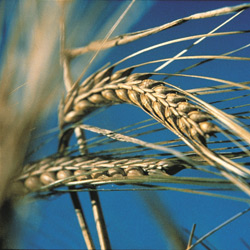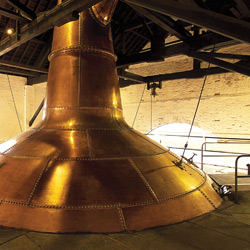“A noble libation, aged in oak casks and steeped as much in tradition as multi-layered flavor, whiskey takes time—time to make, and time to understand.”
–“Whiskey Lover’s Tasting Guide,” Pernod Ricard USA
With its complex layers of aromas and flavors and high alcohol content, whiskey isn’t the easiest of drinks to embrace. Despite the meaning of the word itself—a Gaelic translation of the Latin phrase aqua vitae, or “water of life”—it is, for many, an acquired taste. Yet just as the wine connoisseur develops an appreciation for the geography, history and unique qualities of different kinds of wine, so does the whiskey lover. And with a wider range of flavors than any other distilled spirit, it can be a thoroughly rewarding adventure.
In short, whiskey refers to an alcoholic beverage distilled from a fermented mash of grain, such as barley, rye or corn. The art of distillation, which involves the heating of liquids to create steam, originated in the Middle East, and, it is believed, made its way to Europe between the 6th and 7th centuries. The distillation process was first used to create perfumes before it was used to make alcoholic beverages.
After distillation, the whiskey solution—a clear liquid at this point—is aged in wooden barrels, usually made from charred oak. This process can last anywhere from two years for cheap bourbons to a decade or more for high-end whiskies. During aging, the solution interacts with the wood of the barrel, which alters its chemical makeup and has a tremendous impact on the whiskey’s flavor and color.
Unlike wine, whiskey does not mature in the bottle—its age is considered the time between distillation and bottling. Whiskeys that have been in the bottle for many years are not “older” or better than more recent whiskeys that were aged in the barrel for the same amount of time.
An incredible range of whiskeys are produced in countries all over the world, but the main countries of origin are Scotland, Ireland, the United States and Canada.
 The Story of Scotch
The Story of Scotch
A scotch is, of course, a whisky from Scotland, a country that boasts more distilleries than any other. The first documentation of whisky-making can be found in Scottish records dating to 1494, and its earliest distillers were monks and barbers who, at the time, acted more like doctors. Both groups were dedicated believers in the medicinal properties of whisky.
Scotch whiskies are distinguished by a smoky malt flavor, derived by using malted barley that has been heated and dried over an open peat fire. To be considered a Scotch whisky, a spirit must meet the standards of the United Kingdom’s Scotch Whisky Order of 1990:
- Must be distilled at a Scottish distillery from water and malted barley, to which only other whole grains may be added, have been processed at that distillery into a mash, converted to a fermentable substrate only by endogenous enzyme systems, and fermented only by the addition of yeast
- Must be distilled to an alcoholic strength of less than 94.8 percent by volume so that it retains the flavor of the raw materials used in its production
- Must be matured in Scotland in oak casks for no less than three years and a day
- Must not contain any added substance other than water and caramel colouring
- May not be bottled at less than 40-percent alcohol by volume.
A single-malt scotch is the result of a single production process at a single distillery. Because single malts are not blended with other whiskies, they are the most individualistic, and their qualities are greatly influenced by the climate, water and geography of the region from which they come. Part of the fun of being an aficionado involves “tasting the geography” of the spirit, “from the gentle and subtly complex whiskies of the Scottish Lowlands to the firmer, sometimes spicy whiskies in the Highlands, to the briny and often smoky whiskies from the Scottish coastlines and islands.” (Whisky 101, maltadvocate.com)
As its name would imply, a blended scotch combines many different single malts and grain whiskies into one smooth blend. By blending together a range of whiskies, the rougher edges are smoothed out and the gaps in its flavor profile are filled in. Blended scotches are generally more accessible and far outsell the single malts.
Spirit of the Emerald Isle
“Ireland and Scotland are the two great, original whiskey nations,” notes connoisseur Michael Jackson in his authoritative Whiskey: The Definitive Guide. And yet just a handful of working distilleries remain in the Emerald Isle today, in contrast to Scotland’s nearly 100. This explains why there are so many more Scotch whiskies than Irish whiskeys.
Jameson and Bushmills are the giants of Irish whiskeys. The two distillers share a centuries-old competitive rivalry, and each has a long, storied history. The Bushmills distillery in Ireland is the oldest in the world, having received its license from King James I in 1608.
Like Scotch whisky, Irish whiskey is distilled primarily from barley, but unlike scotch, it is made from both malted and unmalted grains, which gives rise to its distinctive sweetness. Unlike scotch, peat is rarely used in the malting process, and so Irish whiskeys generally lack the smoky flavor of Scotch whiskies. Most Irish whiskeys are distilled three times, while scotch is generally distilled only twice, accounting for its lighter taste. Irish whiskeys are also aged for a longer time than scotch.
Unique to Ireland, “pure pot still” is a single whiskey made from a mixture of malted and unmalted barley and distilled in a traditional copper pot still. Just a single distillery in Ireland makes pure pot still whiskey today.
 Made in America
Made in America
In the early colonial days, Scotch-Irish immigrants began to settle the frontier west of the Appalachian Mountains—and they brought their stills with them. They soon discovered that corn grew better in the New World than other grains, but distilled just as well, and so it became the grain of choice for American whiskeys, setting them apart from their Scotch and Irish counterparts. “It’s thanks to corn that America has a truly indigenous spirit,” notes wine, food and travel writer Margaret Swaine.
Bourbon is the most well-known style of American whiskey, named for Bourbon County, Kentucky, where it was first produced in 1789. Today, an estimated 95 percent of the world’s bourbon is distilled in the Bluegrass State. In 1964, Congress declared it “America’s Native Spirit.” By law, to be considered bourbon, a spirit must be made in the United States, distilled from a mash of no less than 51-percent corn, and aged in new, charred oak barrels for at least two years, among other requirements.
The typical grain mixture for bourbon includes 70-percent corn; the rest is made up of wheat, rye and/or malted barley. This is the mash, which then goes through a process called sour mash fermentation before being placed in charred oak barrels for aging. The aging process is what gives bourbon its rich, reddish-brown color and unique flavor—it is a clear, colorless liquid prior to aging.
Rye whiskeys are made from a mash consisting of no less than 51-percent rye. They impart a sharp, spicy flavor, in contrast to the sweetness of bourbon. In recent years, rye whiskeys have enjoyed a revival of sorts, after being largely ignored since their pre-Prohibition heyday.
Finally, there is Tennessee whiskey, which is made just like bourbon, but with the addition of one step. After distillation, the whiskey is filtered through a thick layer of firmly-packed maple charcoal before being placed in barrels for aging. This special process, called charcoal mellowing, changes the whiskey’s flavor profile and gives it a distinct smoothness. Jack Daniels is a Tennessee whiskey, not a bourbon, as is commonly believed.
Oh, Canada
Canadian whiskies are primarily blended in the Scottish manner, but unlike scotch, they contain a large percentage of rye. They traditionally consist of a blend of a base whisky, usually made from corn, and a flavoring whisky with a high rye content. They are the lightest whiskies of the major distilling countries in both color and flavor.
Hiram Walker’s 1884 launch of Canadian Club marked the beginning of a national style. Walker used an unusually long distillation process that produced a very clean master whisky, which he then blended with neutral spirits. Canadian Club’s light, fruity style has become the standard for Canadian whiskies. This lighter style makes for a year-round appeal and is well suited for mixed drinks and cocktails. a&s
Whiskey Cocktails
The first cocktails appeared in New Orleans in the 1830s, and during their golden age—from 1880 to 1912—they became more ambitious. The Manhattan reigned over New York City, while the Bourbon Old Fashioned was introduced in Louisville.
Whiskey Sour
1 ½ fl oz whiskey of choice
1 ½ Tbsp fresh lemon juice
2 Tbsp simple syrup (50/50 superfine sugar and water; mix, and use when the cloudiness clears)
Shake ingredients with ice and strain into an old-fashioned glass. Garnish with a cherry and a slice of orange.
Mint Julep
1 Tbsp simple syrup
2 sprigs mint (use tender, young sprigs—they last longer and look better in the glass)
2 fl oz bonded bourbon
Muddle one sprig of mint in a mixing glass with syrup. Add the bourbon and strain into a highball glass filled with crushed ice. Swirl with a bar spoon until the outside of the glass frosts. Garnish with a sprig of mint.
Manhattan
2 ¼ fl oz blended whiskey
¾ fl oz Italian sweet vermouth
2 dashes angostura bitters
Stir with ice to chill, and strain into a chilled cocktail glass. Garnish with a cherry.
Source: Whiskey: The Definitive World Guide by Michael Jackson


